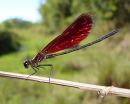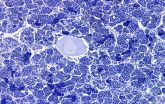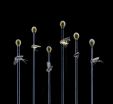Damselfly war games
Flying insects take note of opponents' strengths and abilities before entering into a fight
2015-03-25
(Press-News.org) Before a male damselfly hot-headedly enters into a duel of aerial sparring, it first works out its strategy. It gives its opponent's wings a once-over to assess its strength, knowing that more transparent wings and larger red spots generally show a stronger rival. Those who then decide to engage in long fights either try to wear their opponent down, or dazzle them with brilliant aerial moves that are too hard to follow. These damselfly war game strategies are set out in a study published in Springer's journal The Science of Nature - Naturwissenschaften. Two research groups united forces to arrive at these findings, one based in Brazil, led by Rhainer Guillermo-Ferreira, and the other in Germany, led by Stanislav Gorb.
Male Mnesarete pudica damselflies, like many other winged insects, engage in energy-consuming aerial stand-offs to secure the best mates and territory. To find out how these insects decide whether or not to take up a challenger, Guillermo-Ferreira and his colleagues conducted fieldwork at a stream in Sao Paulo State in Brazil. Among other things, they filmed territorial fights and experimentally manipulated the wing pigmentation of some males.
The researchers realized that strong male damselflies probably adopt various decision-making strategies and steps before and while they take on a challenger of different strengths. To assess whether an opponent is weak or not, they first take wing pigmentation into account. Males with more transparent wings and bigger red spots are usually stronger.
Strong males tend to solve conflicts against weaker opponents through less energy-taxing, but much more aggressive, tactics such as chasing, grabbing, and biting. Because weaker males have less energy to fight, they only engage in brief pursuits without making too much effort during aerial displays.
When two strong opponents take each other on they will limit their chances of injury by choosing to go head-to-head in non-contact aerial display fights that are longer and more intense. In such cases males generally use two strategies. Through the so-called war-of-attrition strategy they physically try to wear their opponents down through repeated attacks. Threat displays, which are typical of longer fights, are then used until one of the contestants reaches his physical limits and withdraws.
The strong males could also follow a sequential assessment model in which they regularly take a step back mid-fight to assess the situation to decide whether it's worth their while to continue or not. In such cases, aerial displays of increasing difficulty are performed until the first damselfly is not able to perform a routine and gives up.
"Even animals with simple nervous systems, such as damselflies and other insects, may exhibit complex assessment strategies," says Guillermo-Ferreira.
INFORMATION:
Reference: Guillermo-Ferreira, R.; Gorb, S.N; Appel, E.; Kovalev, A.; Bispo, P.C. (2015). Variable assessment of wing colouration in aerial contests of the red-winged damselfly Mnesarete pudica (Zygoptera, Calopterygidae), The Science of Nature - Naturwissenschaften. DOI 10.1007/s00114-015-1261-z
[Attachments] See images for this press release:


ELSE PRESS RELEASES FROM THIS DATE:
2015-03-25
By combining observations from the Japan-led Suzaku X-ray satellite and the European Space Agency's infrared Herschel Space Observatory, scientists have connected a fierce "wind" produced near a galaxy's monster black hole to an outward torrent of cold gas a thousand light-years across. The finding validates a long-suspected feedback mechanism enabling a supermassive black hole to influence the evolution of its host galaxy.
"This is the first study directly connecting a galaxy's actively 'feeding' black hole to features found at much larger physical scales," said lead ...
2015-03-25
The American Gastroenterological Association (AGA) has released new guidelines on the management of asymptomatic neoplastic pancreatic cysts found incidentally during computed tomography (CT) or magnetic resonance imaging (MRI). The author of a commentary being published in Annals of Internal Medicine explains how the AGA's bold new recommendations will affect the way physicians consider diagnostic testing. The new guidelines back away from previous recommendations that were more aggressive. Rather than promote invasive work-up, surveillance, or surgery for typical patients, ...
2015-03-25
After six years of painstaking research, a UCLA-led team has validated the first standardized protocol for measuring one of the earliest signs of Alzheimer's disease -- the atrophy of the part of the brain known as the hippocampus.
The finding marks the final step in an international consortium's successful effort to develop a unified and reliable approach to assessing signs of Alzheimer's-related neurodegeneration through structural imaging tests, a staple in the diagnosis and monitoring of the disease. The study is published in the journal Alzheimer's and Dementia.
Using ...
2015-03-25
MELBOURNE, FLA. -- Reef-building corals, already thought to be living near their upper thermal limits, are experiencing unprecedented declines as the world's oceans continue to warm. New evidence from scientists at Florida Institute of Technology shows there may be some climate refuges where corals will survive in the future.
The study appears in the March issue of Global Change Biology.
Ph.D. student Chris Cacciapaglia and his advisor, Robert van Woesik, hypothesized that not all regions of the oceans are warming at the same rate.
"The idea was to identify regions ...
2015-03-25
Tracking the rotation speed of solid planets, like the Earth and Mars, is a relatively simple task: Just measure the time it takes for a surface feature to roll into view again. But giant gas planets Jupiter and Saturn are more problematic for planetary scientists, as they both lack measureable solid surfaces and are covered by thick layers of clouds, foiling direct visual measurements by space probes. Saturn has presented an even greater challenge to scientists, as different parts of this sweltering ball of hydrogen and helium are known to rotate at different speeds, whereas ...
2015-03-25
(New York - March 25, 2015) Induced pluripotent stem cells (iPSCs) -- adult cells reprogrammed back to an embryonic stem cell-like state--may better model the genetic contributions to each patient's particular disease. In a process called cellular reprogramming, researchers at Icahn School of Medicine at Mount Sinai have taken mature blood cells from patients with myelodysplastic syndrome (MDS) and reprogrammed them back into iPSCs to study the genetic origins of this rare blood cancer. The results appear in an upcoming issue of Nature Biotechnology.
In MDS, genetic mutations ...
2015-03-25
CORVALLIS, Ore. - Deep-water marine fish living on the continental slopes at depths from 2,000 feet to one mile have liver pathologies, tumors and other health problems that may be linked to human-caused pollution, one of the first studies of its type has found.
The research, conducted in the Bay of Biscay west of France, also discovered the first case of a deep water fish species with an "intersex" condition, a blend of male and female sex organs. The sampling was done in an area with no apparent point-source pollution, and appears to reflect general ocean conditions.
The ...
2015-03-25
DURHAM, N.C. -- The value of many oceanfront properties on the East Coast could drop dramatically if Congress were to suddenly end federal beach nourishment subsidies, a new study by researchers at three universities finds.
In beach nourishment, new sand, often dredged from nearby inlets or the offshore sea floor, is added to an eroding beach to widen it and help prevent future erosion.
"The expectation that the federal government will continue to provide subsidies for erosion-control measures has significantly inflated property values in many coastal communities," ...
2015-03-25
Would-be participants of higher education must be given full and transparent advice before they accumulate debts as students that follow them into the workplace, according to a report published in the International Journal of Pluralism and Economics Education.
Deborah Figart of the School of Education, at The Richard Stockton College of New Jersey in Galloway, says that there is a dearth of pre-loan and post-loan counseling for undergraduate students using student loans to help finance their higher education. She has devised an assignment that can be adapted to a wide ...
2015-03-25
A new paper to be published in the journal Zootaxa (April 6, 2015) describes 30 new insect species in a single genus, Megaselia, of the fly family Phoridae. Describing 30 species in a single paper is rare, but what's especially striking is that all these come from urban Los Angeles.
The discoveries come from researchers in the BioSCAN project (Biodiversity Science: City and Nature) at the Natural History Museum of Los Angeles County (NHM). The BioSCAN project is a three year investigation of patterns of biodiversity in and around urban Los Angeles, based on sampling ...
LAST 30 PRESS RELEASES:
[Press-News.org] Damselfly war games
Flying insects take note of opponents' strengths and abilities before entering into a fight





